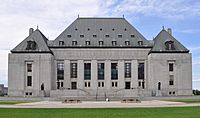R v Gladue facts for kids
Quick facts for kids R v Gladue |
|
|---|---|

|
|
| Hearing: April 23, 1999 Judgment: December 19, 1999 |
|
| Full case name | Jamie Tanis Gladue v Her Majesty the Queen |
| Citations | [1999] 1 SCR 688 |
| Ruling | Appeal dismissed |
| Court membership | |
| Chief Justice: Antonio Lamer Puisne Justices: Claire L'Heureux-Dubé, Charles Gonthier, Peter Cory, Beverley McLachlin, Frank Iacobucci, John C. Major, Michel Bastarache, Ian Binnie |
|
| Reasons given | |
| Unanimous reasons by | Cory and Iacobucci JJ |
| McLachlin and Major JJ took no part in the consideration or decision of the case. | |
| Laws applied | |
| Criminal Code, s. 718.2(e) | |
R v Gladue is an important decision from the Supreme Court of Canada. It helps judges understand how to decide sentences for people who have committed crimes, especially for Indigenous offenders. The case focuses on a specific part of Canada's law, called section 718.2(e) of the Criminal Code.
This law was created in 1995. It tells judges to think about all possible punishments that are not going to prison. It also says that judges must pay "special attention" to the unique situations of Indigenous people when deciding their sentences.
The Gladue case was the first time the Supreme Court explained what this law means. The Court upheld a three-year prison sentence for a person named Jamie Tanis Gladue. But it also explained important things judges must consider when using section 718.2(e).
Since this decision, special reports called "Gladue reports" are often used. These reports help judges learn about an Indigenous person's background before sentencing them. This helps make sure the sentence is fair and considers their life experiences. In 2012, another Supreme Court case, R v Ipeelee, confirmed these important ideas from R v Gladue.
Contents
What Happened in the Case?
On September 16, 1995, a young Indigenous woman named Jamie Tanis Gladue was involved in a serious incident in Nanaimo, British Columbia. This incident led to the death of her boyfriend.
Decisions by Lower Courts
Jamie Tanis Gladue was first charged with a very serious crime. However, she later admitted to a less serious charge called manslaughter. This was agreed upon by the prosecutor. The main question for the court was what her sentence should be. She was sentenced to three years in prison.
During her sentencing, the judge looked at different things. These included factors that made the crime more serious and factors that made it less serious. The judge noted that Gladue did not have a long history of serious crimes. However, the judge did not consider anything specific about Gladue's Indigenous background. The judge also thought that section 718.2(e) of the Criminal Code did not apply to Indigenous people who lived off a reserve.
The British Columbia Court of Appeal disagreed with the judge on that point. But, by a vote of two to one, they still agreed with the three-year sentence. Both the first judge and the majority of the Court of Appeal felt the crime was serious. They believed a three-year sentence was fair, even if Gladue's Indigenous background was considered.
Supreme Court's Decision
The Supreme Court of Canada agreed with the three-year sentence. However, they carefully explained how judges should use the new sentencing law, section 718.2(e). Justices Cory and Iacobucci wrote that the lower courts had misunderstood this law.
They explained that the law was created to fix a big problem. Too many Indigenous people are in Canada's justice system. The law aims to help reduce this over-representation.
The Supreme Court also corrected the idea that section 718.2(e) only applies to Indigenous people living on reserves. They clearly stated that this law applies to "all aboriginal persons wherever they reside." This means it applies whether they live on a reserve, off a reserve, in a big city, or in a rural area.
Understanding Gladue Reports
After the Supreme Court's decision, courts started asking for special reports. These are called Gladue reports. They are prepared for Indigenous people who are being sentenced. These reports specifically look at the factors that the Supreme Court said were important under section 718.2(e).
Parliament created this law to try and lower the high number of Indigenous people in Canada's criminal justice system. Gladue reports help judges understand the unique life experiences of Indigenous offenders. These reports can include information about:
- The difficult history Indigenous peoples have faced.
- Cultural challenges and unfair treatment.
- Poverty and hardship.
- Experiences of abuse.
- Attending residential schools.
This information helps judges make more fair and appropriate sentencing decisions.
See Also
- Gladue court
- Gladue report
- Healing lodge
- Indigenous Peoples and the Canadian Criminal Justice System
- R v Ipeelee

